Whispers of the Trees: A Guide to Sacred Forests in Ireland
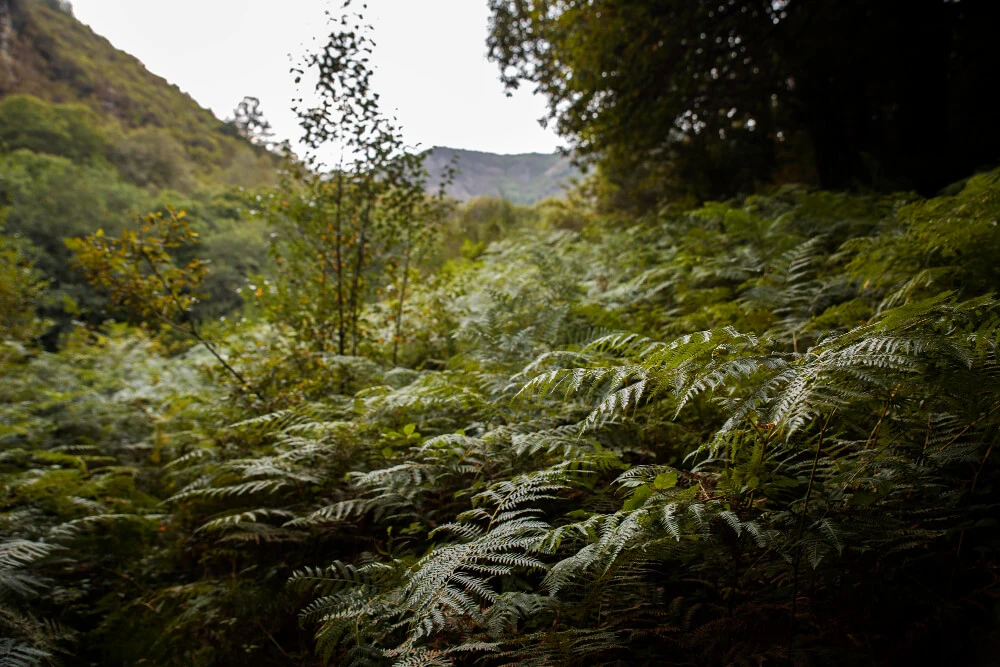
Updated On: April 23, 2024 by Yasmin Elwan
In the verdant isle of Ireland, the whispering leaves and stoic stands of ancient groves carry tales as old as time. These sacred forests in Ireland and solitary sentinels are not just a part of a natural landscape but serve as a reminder of Ireland’s spiritual and cultural fabric that has been interwoven with the lives and beliefs of its people through the centuries. From the spiritual significance of the mighty oak to the mystical hazel, each tree holds a place in Ireland’s heart, fostering a connection that echoes the nation’s history, mysticism, and a deep appreciation for nature.
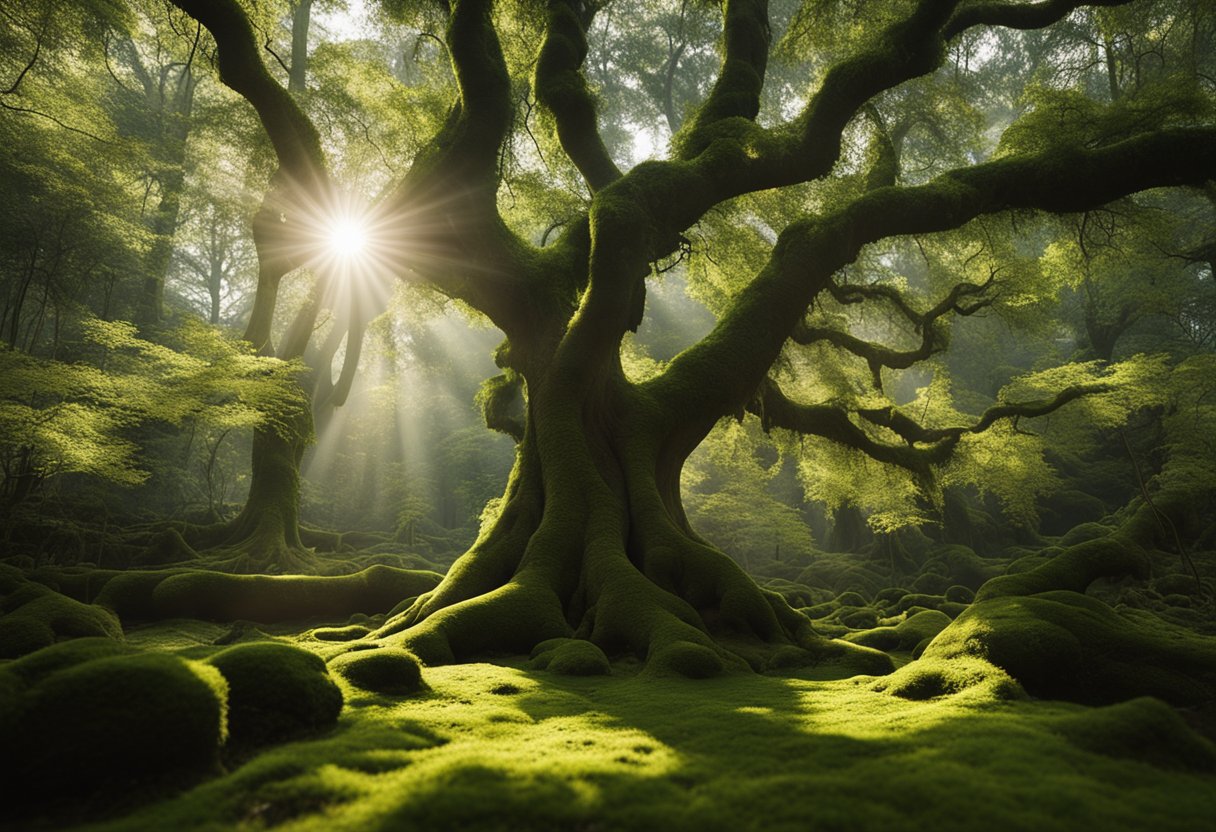
Trees in Ireland are more than just biological entities; they are cultural icons, integral to a range of practices from traditional rituals to their roles in tales of legends and the ancient Ogham script, known as the tree alphabet.
As we delve into Ireland’s sacred forests, we uncover how these timeless beings encapsulate the spirit of Ireland, harbouring biodiversity and inspiring a bond that is celebrated through various forms of expression, from music and poetry to the very art of storytelling itself. The enduring legacy of Ireland’s trees, in tandem with growing environmental concerns, prompts us to consider their future and our responsibility to preserve these living monuments.
The Spirit of Ireland’s Forests
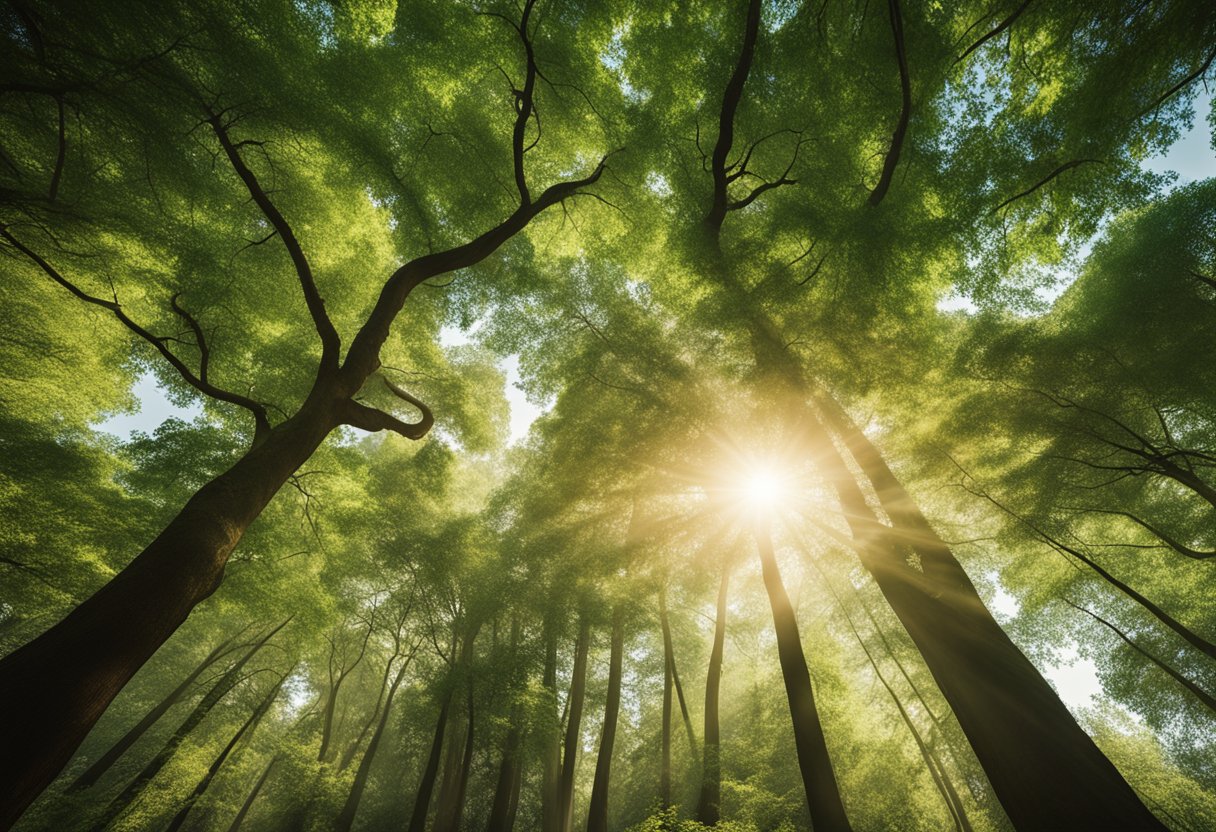
Ireland’s ancient forests are steeped in a rich tapestry of cultural and mythical significance, often seen as gateways to other worlds and holding a sacred place in Irish heritage.
Sacred Trees in Irish Culture
In our culture, trees are not just part of the landscape; they embody the sacred essence of Ireland’s past. The veneration of trees is a time-honoured tradition, with certain species, such as the oak, ash, and yew, holding significant roles due to their longevity and stature. These sacred trees were once considered the abodes of gods and spirits, serving as central figures in community gatherings and legal ceremonies.
Trees and Irish Mythology
Trees in Irish mythology serve as vivid characters and symbols. According to Irish folklore, whispers of the trees might carry messages from the otherworldly realms. Myths speak of the five great guardian trees, which were thought to protect the whole of Ireland. One such tree is recorded in The Irish Post; the Eó Mugna is believed to bestow powerful wisdom upon those who encounter it.
Folklore and Superstitions
Our folklore is brimming with tales of fairy trees, frequently hawthorn trees standing alone in a field. There is a superstition that disturbing these trees would bring misfortune, as they are the favoured haunts of fairies. Such beliefs reinforce the idea that trees are more than mere plants; they are a fundamental part of the spiritual fabric of Ireland. Through Connolly Cove, we’ve learned that in many stories, trees are respected as the keepers of ancient knowledge and the connectors between the worlds.
Historical Significance of the Sacred Forests in Ireland
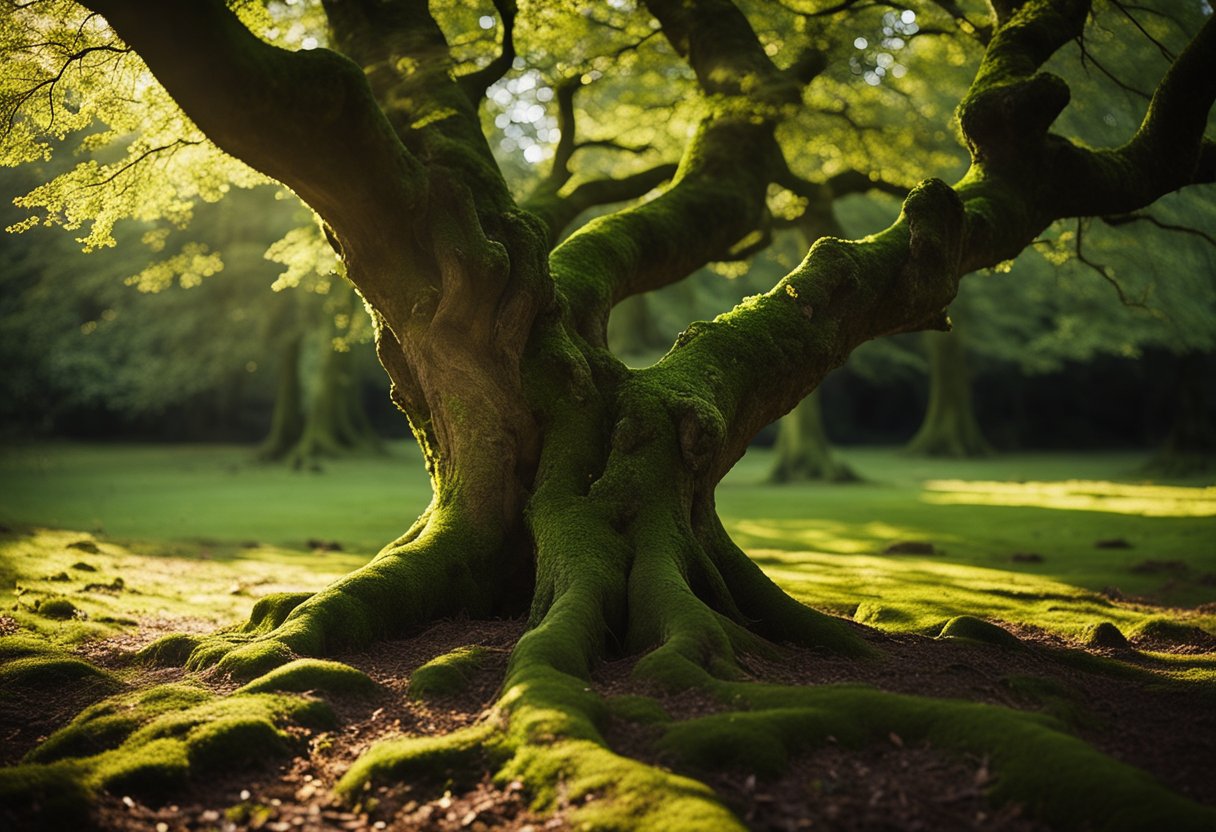
In this section, we explore the profound connection between Ireland’s rich history and its forests, highlighting the pivotal role trees have played within the cultural and spiritual life of the country.
Ancient Ties to Nature
Ireland’s landscapes are steeped in history, with trees deeply rooted not only in the soil but also in the very fabric of Irish heritage. Our ancestors recognised the ecological importance of woodland, observing how the trees of Ireland sustained both the land and the people. This relationship was enshrined in the ancient Brehon Laws, which detailed specific penalties for damaging different tree species, thus safeguarding forests and venerating them as a crucial part of the natural world.
The Role of Trees in Irish History
Throughout Irish history, certain trees have achieved almost sacred status and have become known as the sacred trees of Ireland. These revered trees, or ‘bile’ as they were known, often stood at the heart of communities. Clans and kings of Ireland would gather at these majestic specimens for important ceremonies, including royal inaugurations at places like Bile Tortan.
The connection between people and trees was further manifested in the Ogham alphabet, with each character representing a different tree species. This early script not only communicated language but also expressed the bond between Irish society and their surrounding forests, integrating the natural world into the earliest forms of our literacy and identity.
Cultural Icons and Traditions
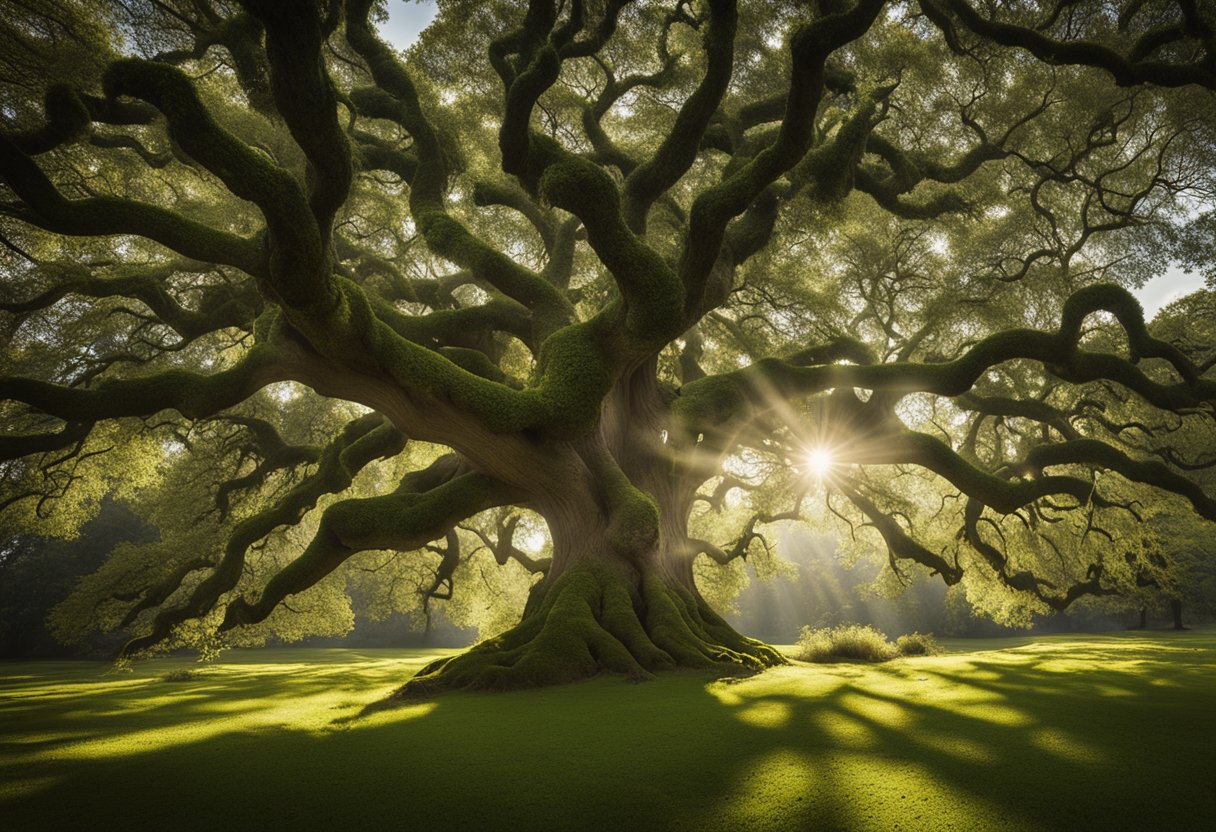
In exploring Ireland’s rich landscape, we uncover the profound connection between nature and the Emerald Isle’s cultural fabric. Our forests not only harbour biodiversity but also cradle the nation’s soul, steeped in sagas, legends, and age-old traditions.
Symbolic Trees and Sagas
Every sacred tree in Ireland whispers tales of old, embodying a wealth of symbolism and knowledge. Oaks, Ashes, and Yews are not merely wooden pillars; they are storied icons of wisdom and magic. Whether in the earliest sagas or occupying centre stage in Celtic mythology, these trees serve as living connections to our ancestral past, each one a symbol signifying a distinct aspect of our cultural identity.
Legends of Sacred Wells
Bubbling beneath the canopies, holy wells spring forth as portals to a deeper understanding, fusing the natural and the mystical. These wells are not mere sources of water but are revered sites of healing, meaning, and tradition. Where they flow, legends gather—stories of saints, the enchantments of faeries, and practices of leaving offerings, a custom woven into the fabric of our cultural tapestry.
Biology and Ecology of Irish Trees
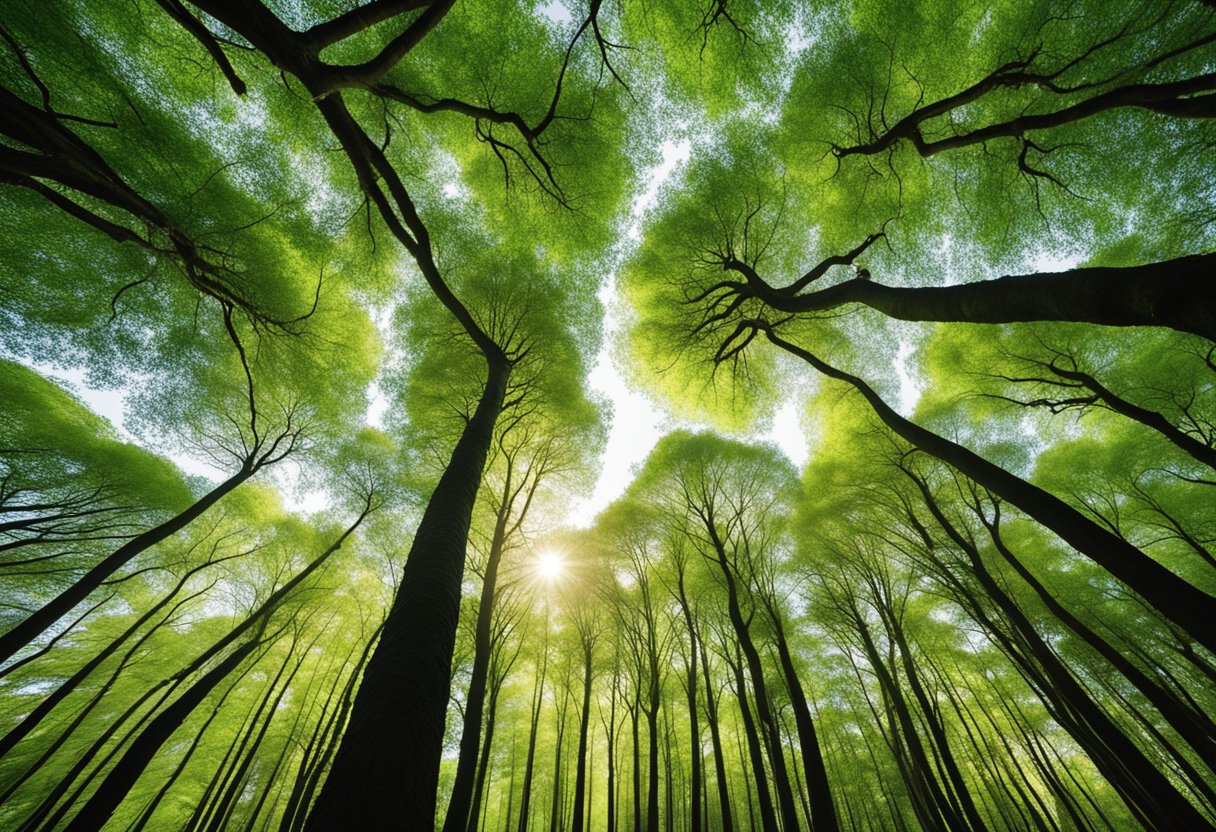
Ireland’s landscapes are etched with a verdant tapestry of woodland, where each tree species contributes to the island’s ecological majesty and biological richness. We shall explore the fundamental role native flora plays in these ecosystems and the significance of sacred groves in Irish heritage.
Native Flora Explained
Our country’s native trees form essential cornerstones of our biodiversity. The ash stands tall with its distinctive compound leaves, acting as a habitat for myriad wildlife species. Majestic oak trees, with their robust trunks and sprawling branches, are keystone species supporting a complex web of life.
Similarly, the birch, with its silvery bark, and the alder, often found along riverbanks, both offer unique ecosystems for various birds and insects. The hawthorn, with its white blossoms, is intertwined with folklore, whereas the twisting willow is commonly associated with waterways.
In Ireland, the yew tree, often found in graveyards, is revered for its longevity and traditionally symbolises death and resurrection. The hazel is synonymous with wisdom in Celtic mythology and provides sustenance for wildlife through its nuts.
The humble elder, with its clusters of fragrant flowers, is frequented by a variety of pollinators, and its berries attract birds. The noble Scots pine, the sole native conifer, stands proudly as part of Ireland’s ancient forest remnant. Fruit-bearing trees such as the apple have been cultivated for centuries, and the prickly holly, with its glossy green leaves, brings vibrant colour to winter landscapes.
Understanding Sacred Grove Ecosystems
Sacred groves, hailed as sanctuaries in Irish tradition, are thriving realms where biodiversity flourishes within a sanctified space. These ecosystems, often undisturbed due to their spiritual significance, have become biodiversity hotspots. For example, the intense ecological relationships within an ancient oak grove where lichens, invertebrates, and fungi thrive under a canopy that regulates sunlight and humidity, creating a microcosm of life unique to these sacred spaces.
Particular tree species such as the yew and hawthorn have long been venerated and are frequently found at the heart of these groves, reflecting their esteemed status in folklore and mythology. The preservation of such groves not only safeguards our native flora but also ensures that the complex ecology of these sites continues to underpin the remarkable tapestry that is Ireland’s natural heritage.
Environmental Concerns
As we traverse the topic of Ireland’s sacred forests, our concern is twofold: to understand the effects of deforestation and to acknowledge the strides made in conservation efforts.
Deforestation and its Impact
Deforestation, the clearing of trees on a massive scale, has threatened Ireland’s forests for centuries. Agriculture has been a primary cause, as land is cleared to make way for grazing and crops. The environmental concerns are significant, with deforestation contributing to habitat loss, reduced biodiversity, and increased greenhouse gas emissions that exacerbate climate change. In recent times, a focus has been on fast-growing conifer species, often at the expense of native broadleaf varieties, altering the ecological balance and landscape.
Conservation Efforts
In response to these concerns, conservation efforts have been amplified. These include initiatives to restore native forests and diversify the species planted. Science and research play pivotal roles in these conservation endeavours, guiding sustainable practices and informing agricultural policies that balance production with environmental stewardship. Efforts are also made to bolster the connection between people and these ancient woodlands, as understanding is a key to conserving our natural heritage.
Rituals and Practices
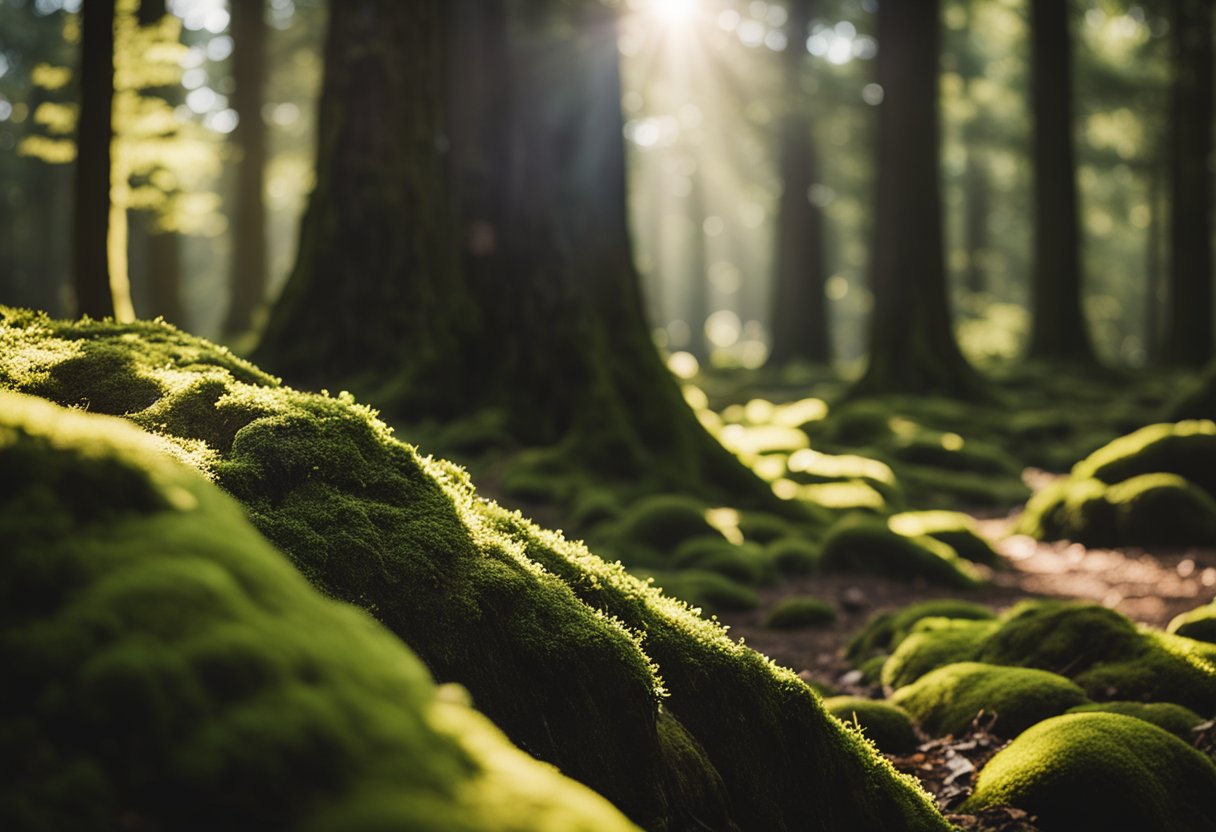
In Ireland’s verdant groves, our veneration of trees intertwines with centuries-old rituals and practices, forming a tapestry of cultural heritage that spans from Pagan beliefs to Christian traditions.
Veneration and Ceremonies
Trees have long been at the heart of our ceremonies. Sacred trees, or bile, were once central to Irish royal inauguration sites and symbolised the heart of the community. This veneration of trees in Irish culture is evident in the remnants of forest worship that survived through the ages, where trees represented living connections to our ancestors and the spirit world. Rituals, such as tying cloth strips to branches at wishing trees, reflect our desire to connect with the spiritual realm and are an enduring part of our tradition.
The hawthorn tree, often associated with Irish fairy folklore, is deemed so sacred that to cut one down would invite misfortune. Our traditions prescribe placing offerings or tokens on these trees, a gesture meant to appease the otherworldly inhabitants or fairies believed to dwell within.
The Intersection of Paganism and Christianity
Our spiritual landscape is dotted with examples of where Paganism and Christianity coalesce. Early Christian monks often elected to establish sites of worship near pre-existing sacred groves, thereby reflecting an intriguing intersection of beliefs. This blending is apparent in the retention of pre-Christian festival dates, repurposed to fit the Christian calendar. One such ceremony is the lighting of Bonfires on St. John’s Eve, echoing the ancient pagan ritual of Bealtaine, originally a fire festival celebrating the start of summer.
Festivals and ceremonies held under these ancient boughs continue these dual legacies, creating a continuum of reverence rooted deep in the soil of tradition. Thus, our practices at these ritual sites honour both the Christian sacraments and the older pagan customs that Irish culture is loath to forget.
Ogham: The Tree Alphabet
Ogham is an ancient script, often described as the “tree alphabet”, paramount in our understanding of early Irish culture and language.
Deciphering the Ogham Inscriptions
The Ogham alphabet consists of twenty characters, each a unique combination of lines often inscribed on standing stones. To decipher these inscriptions, one must recognise the series of notches and their corresponding letters. Each character in this script represents a specific tree or plant, revealing a rich connection to the natural world. The strokes, placed in relation to a central line, maybe on the right, left, across, or angled to represent individual letters. The process of deciphering these strokes can unveil words, names, and possibly messages from the past.
Cultural Relevance of the Ogham Script
Historically, the Ogham script held significant cultural relevance. It was a medium for writing in Primitive and Old Irish, serving various functions, from commemorating individuals to marking territory. The script’s intimate link with trees places it within a broader spiritual and mythological context, where trees hold sacred importance. Understanding Ogham isn’t just about reading an alphabet; it’s about tapping into an era where literacy and nature were deeply intertwined. This script provides us with a precious glimpse into the lives and beliefs of ancient Irish society.
The Future of Ireland’s Trees
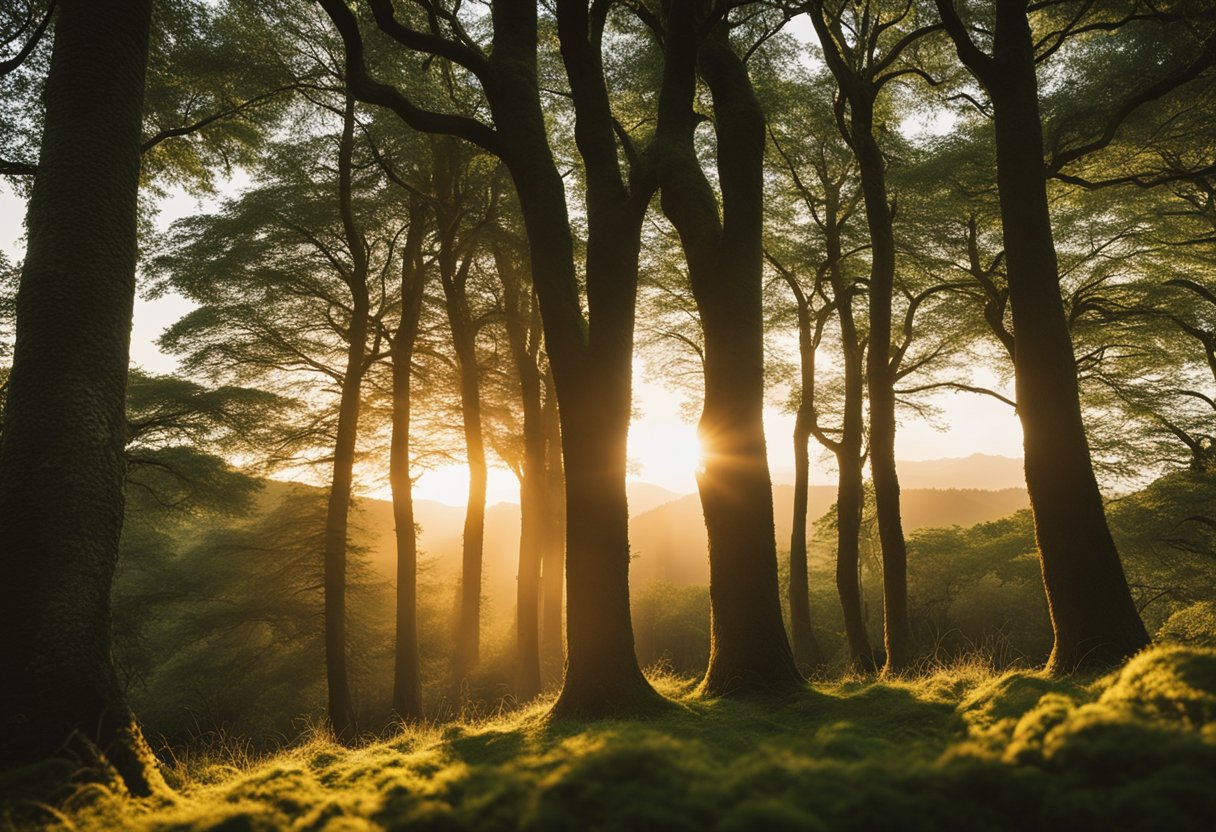
As we explore the path forward for Ireland’s trees, we place emphasis on preserving what remains of our ancient woodlands while fostering a cultural renaissance that reconnects us with our arboreal heritage.
Preserving Irish Woodlands
Our woodlands are not merely landscapes, but are repositories of history and biodiversity. In Ireland, these ecosystems are facing the question of sustainability. We recognise that preserving Irish woodlands is crucial to stablise our climate, enhance biodiversity, and sustain resources for industries such as construction.
The decline in afforestation since 2016 is a trend we must reverse to achieve our environmental and socio-economic goals. Active measures, including implementing policies and increasing public awareness, are essential steps toward a greener future.
Cultural Renaissance
As we navigate the cultural renaissance surrounding our sacred forests, we are witnessing an awakening in public interest and respect for our native woodlands. This renewal has its roots not only in a desire to preserve our environment but also in reclaiming an integral part of our cultural identity. The mystique of Wishing Trees and Fairy Tree traditions reflects the deep connection between the Irish people and their trees, demonstrating the potential for culture-led conservation.
Heritage trees and woodlands in Ireland must be protected and celebrated as they are central to our cultural narrative. Through education, community engagement, and responsible policies, we strive to ensure that Ireland’s trees will thrive for generations to come.
The Symbology of Specific Trees
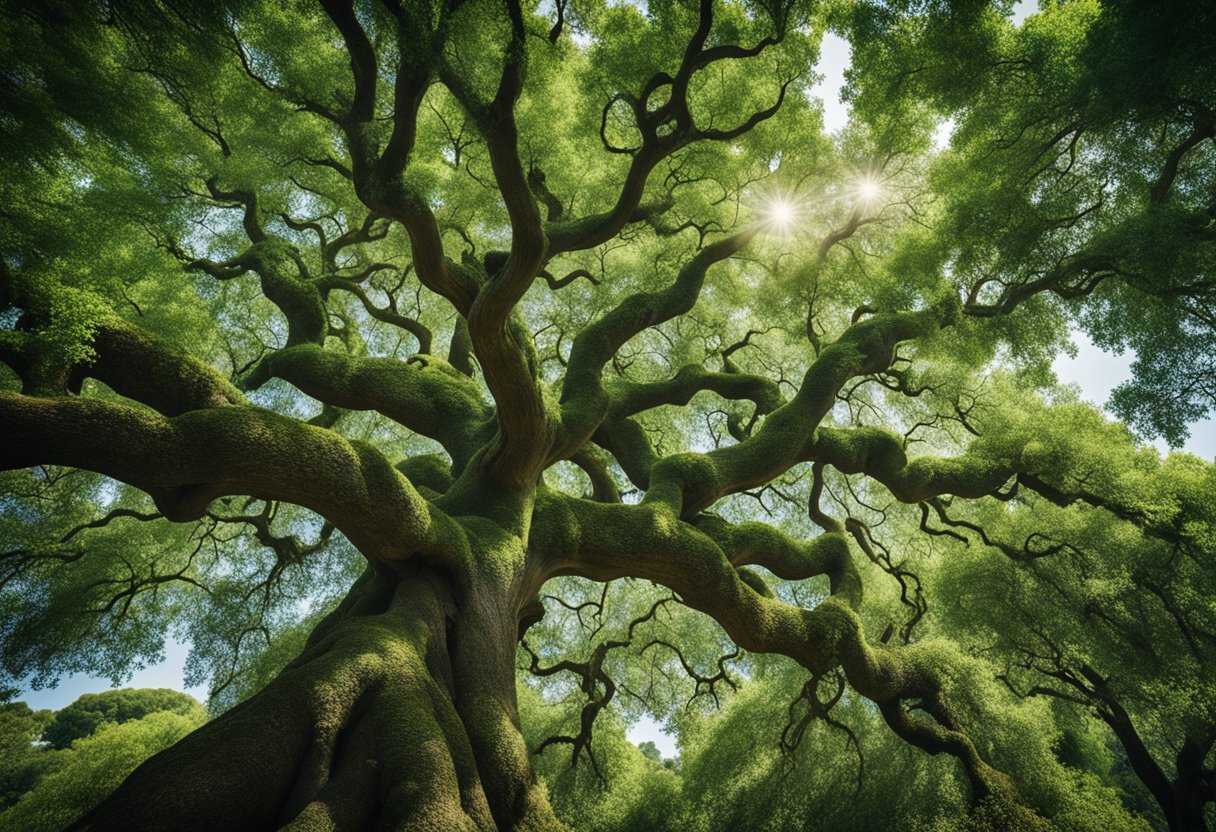
In Ireland, whispers of trees resonate with tales of the sacred and the mystical. Our exploration delves into these significant species, uncovering their profound symbolism and cultural importance.
The Mystical Hawthorn
The hawthorn tree, often found in our sacred groves, is enveloped in mystique and lore. This thorny tree is traditionally associated with the supernatural and was once believed to guard the entrance to the Otherworld. To our ancestors, it represented both protection and connection to the spiritual realm, reflecting a deep-seated reverence in Irish culture.
The Mighty Oak and its Acorns
The oak tree stands as a testament to strength and endurance in the natural world. Emblematic of the druidic tradition‘s reverence for nature, it is heralded as the King of the Forest. The oak’s enduring acorns symbolise potential and growth, resonating with themes of wisdom and nobility—echoes of the ancient Ogham alphabet, where the oak held high significance.
Legends and Storytelling
We can’t speak of Ireland without mentioning the deep connection between its trees and the wealth of stories they’ve inspired. These living pillars of the Irish landscape have been entwined with folklore for centuries, harbouring tales of magic, tradition, and the importance of the natural world in Irish heritage.
Tales of the Trees
Enthralled by the whispering leaves and stoic trunks of our ancient woodlands, Irish poets and storytellers have long turned to the forest for inspiration. One legend speaks of Eó Mugna, an immense oak revered for its supposed power to bear apples, acorns, and hazelnuts, symbolising knowledge and sustenance.
In Clare and Galway, the rugged landscape whispers of holy wells and royal sites, often marked by a solitary tree—believed to house spirits and a portal to other worlds. Our folklore is rich with such stories, wherein trees serve not merely as silent witnesses to history but as vital characters in our nation’s narrative.
Chronicling Tree Lore in Literature
The chronicling of Irish tree lore in literature is as longstanding as the trees themselves. Meticulously gathered within the anthologies of the National Folklore Collection at UCD, these tales have been preserved thanks to the dedication of generations of scholars. They tell of a land where every tree has a story, each leaf a poem.
Irish literature, blooming from this fertile ground, immortalises the symbiotic relationship between the people and the forests, revealing how the natural world is a canvas for human thought and creativity. The pen of the poet and the voice of the bard have been instrumental in ensuring that the spiritual and cultural significance of Ireland’s trees continues to be celebrated and conserved within the rich tapestry of our literary heritage.
Frequently Asked Questions
In this section, we answer some commonly asked questions about Ireland’s sacred forests, shedding light on the species revered in Irish forestry, the historical deforestation events, the current state of ancient woodlands, protection laws, and restoration efforts.
What species are considered sacred in Irish forestry?
Sacred trees in Irish tradition encompass several species, but the most venerated include the oak, ash, yew, and hawthorn. These trees often hold significant standing in Celtic mythology and are found at historic sites.
What historical events led to the decline in Ireland’s tree population?
Ireland’s tree population saw a sharp decline due to extensive timber cutting for shipbuilding in the 16th and 17th centuries, alongside agricultural expansion that required the clearing of forests.
Are there any remnants of Ireland’s ancient woodlands still extant today?
Yes, remnants of the ancient woodlands do exist, with pockets of native forest scattered throughout the country, like the Killarney National Park, which is home to some of Ireland’s oldest oak woods.
During which period was Ireland largely deforested?
The most significant period of deforestation in Ireland occurred during the 18th and 19th centuries, with the island’s tree cover reduced to its lowest by the early 20th century.
How are Ireland’s sacred forests protected by law?
Ireland’s forests, including sacred sites, are protected under various national and EU laws, which provide legal frameworks to preserve biodiversity and safeguard significant natural habitats.
What is being done to restore native woodland in Ireland?
Efforts to restore Ireland’s native woodland include governmental and NGO reforestation initiatives, promoting the planting of indigenous trees, and preserving ancient woodland remnants.






